Dahlias are a great species of flowering plant that need little work but offer a lot of rewards. Part of the Asteraceae family, these extravagant flowering plants grow quickly and produce big, bulbous blooms that range in colour from pastels to bright and brilliant shades.
If you’re wondering how to grow dahlias, here is everything you need to know to cultivate, care for and grow dahlias at home.
More...
Genus: | Dahlia |
|---|---|
Family: | Asteraceae |
Common Name: | Dahlias |
Location: | Outdoor |
Type: | Herbaceous perennial |
Growth: | 1m x 40xm |
Sun requirements: | Full sun |
Foliage Colour: | Green / Black |
Flower Colour: | Yellows, Reds, Orange, Blacks, Purples, Pinks, Greens |
Flowering: | Summer |
Fruit: | None |
Maintenance level: | Low |
Poisonous for pets: | Toxic to cats and dogs |
What are Dahlias?
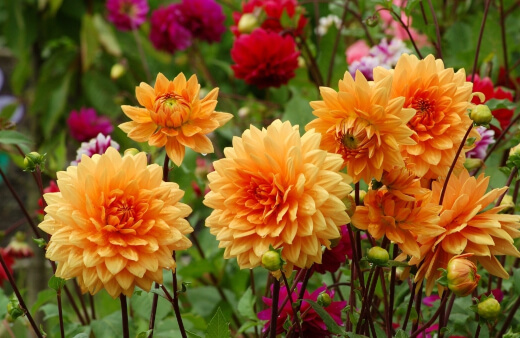
Dahlias are tuberous perennial plants which multiply underground, producing masses of gorgeous colourful firework-like flowers right through summer.
While Dahlias are known for being thirsty plants they grow well in a range of soils provided their roots are shaded, and their tops are in full sun.
Dahlias are true herbaceous perennials, dying back completely in winter and using the fading top growth to feed their thick underground roots, called tubers.
Dahlias’ Natural habitat

Dahlia are native to Central America and Mexico so enjoy tropical conditions and middling humidity in bright, open spaces. In fact, Dahlias are the national flower of Mexico thanks to their popularity as cut flowers, and their long history as an impotent food crop, with their tubers used by the Aztecs to feed growing civilizations.
While there are unlimited numbers of hybridised dahlias grown in our gardens, there are actually just 42 recognised species of dahlia found growing in the wild with variations in height, flowering and leaf colour and texture.
Best Dahlias to Grow in Australia
1. Dahlia ‘Poppers’Dahlia David Howard has painterly red and yellow streaks across each of its petals, forming a tight, spiky pom pom at the end of 1.5m flower stalks. This particular cultivar is a hybrid between pompom and cactus dahlias, and shows it with the tight spikes of petals, gathered together to form a tight ball. If deadheaded regularly, Dahlia ‘Poppers’ can flower right through from late spring to early fall. | 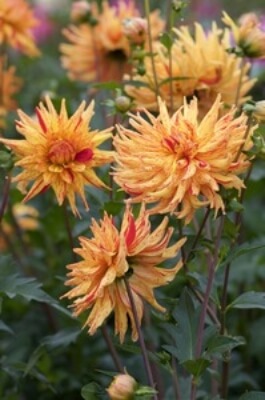 Source: digthedirt.com |
2. Dahlia ‘Arabian Night’The large deep, almost blood red, pompom of Dahlia ‘Arabian Night’ makes it perfect for almost any planting style, with looser foliage that tends not to grow beyond 30-40cm tall making it ideal for mixed borders where flowers are allowed to protrude and shoot up through green carpets. | 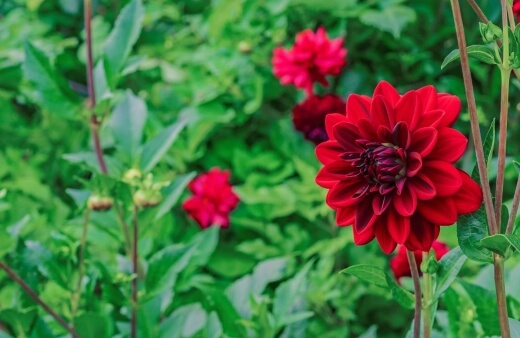 |
3. Dahlia ‘Bishop of Llandaff’Not all dahlias are the showy pompom or cactus types. Some are much more delicate, with subtle flowers more similar to Japanese anemones than the dahlias we tend to be familiar with in Australia. Dahlia ‘Bishop of Llandaff’ is a humble perennial which will reliably flower year after year in Australia, but will need plenty of water to maintain the dark, near black, foliage around its base. |  |
4. Dahlia ‘Brittany Rey’Dahlia ‘Brittany Rey’, affectionately known as Rhubarb and Custard in our house, is an acid pink dahlia, which opens up to reveal a creamy, egg yolk coloured centre. If you want a true shock of colour in your border, you won’t find a more confident dahlias out there. Dahlia ‘Brittany Rey’ grows to just under 1.5m tall in most conditions, but prefers good drainage and regular drinks. | 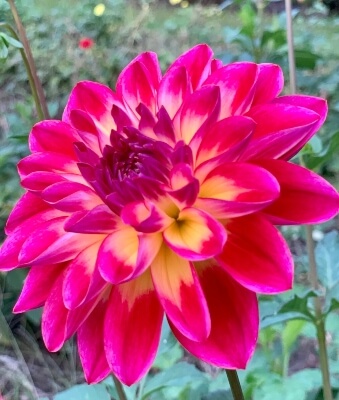 Source: idigdahlias.com |
5. Dahlia ‘Bora Bora’Dahlia ‘Bora Bora’ is a classic cactus dahlia, with tightly curled red petals, each fading to yellow at the centre making them stand out to pollinators. As Dahlia ‘Bora Bora’ reaches just under 1m they can flower quite early, often in late spring. Like any cactus dahlia, check flower buds for signs of damp and remove any dried sepals that are holding flowers shut. This helps to encourage a more open flower. | 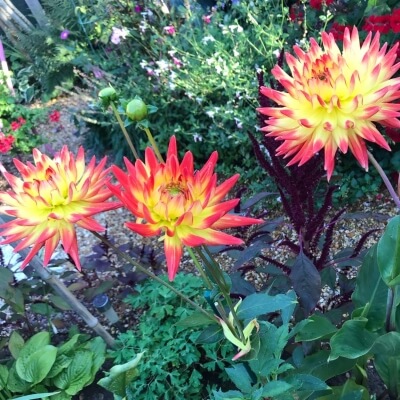 Source: gardentags.com |
6. Dahlia ‘Crazy Love’The elegant blush of Dahlia ‘Crazy Love’ is just stunning. If you’re growing your own bouget, or want to set up your own cut flower border, you shouldn’t be without this classic. Dahlia ‘Crazy Love’ is perfect for the centre of flower arrangements, with long uninterrupted stems that should be cut right back to the lowest node when harvested, allowing new, slender stems to shoot up. Dahlia ‘Crazy Love’ usually grows to around 90cm, but can reach 1m if they are individually mulched around the crown in winter. | 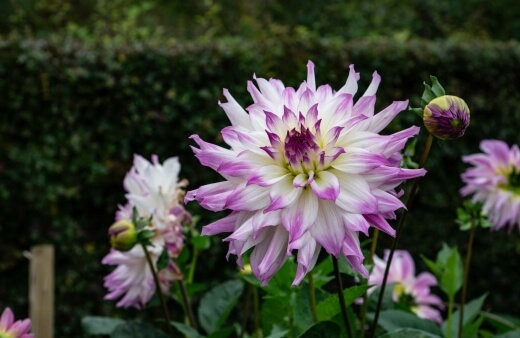 |
7. Dahlia ‘Black Narcissus’Dahlia ‘Black Narcissus’ needs well drained soil and full sun. Any shade will cause stunted or uneven growth, while sitting in water can completely rot their roots. This is a rule for any cactus dahlia, but Dahlia ‘Black Narcissus’ is particularly picky. | 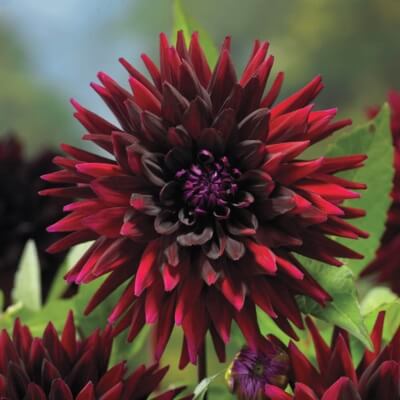 Source: dutchbulbs.com |
8. Dahlia ‘Tutti Frutti’The appropriately named Dahlia ‘Tutti Frutti’ looks just like pulled taffy, with soft pink petals that look good enough to eat (which is lucky, because they’re edible and have a gorgeous carroty flavour). While they’re not the tallest Dahlia, they still reach 90cm in decent conditions, and are relatively simple to grow, tolerating partial shade, and occasional dry spells reasonably well. | 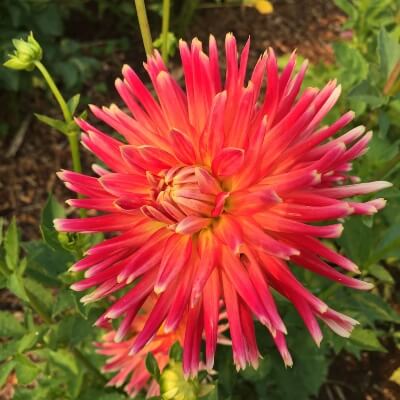 Source: evelyns-garden-and-nursery.myshopify.com |
9. Dahlia ‘Jitterbug’Dahlia ‘Jitterbug’ is a miniature dahlias, and completely perfect for pots, with taller plants shooting through its foliage. The peachy flowers are just 1-2cm in diameter and look great around the base of formal flower arrangements. | 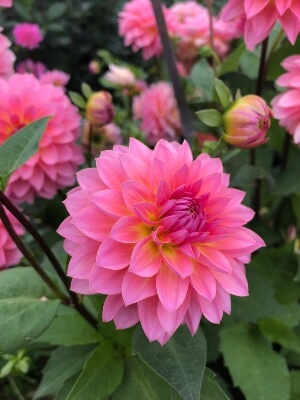 Source: dahliasbyjulie.com |
10. Dahlia ‘David Howard’Named after the British royal gardener David Howard, this dahlia grows to just 75cm so is perfect for formal gardens, where foliage wants to be kept under control. The disadvantage of Dahlia ‘David Howard’ is that they are very susceptible to frost, so can die if left in the ground over winter in southern states. Try to keep them covered or mulch with compost to protect them if possible. | 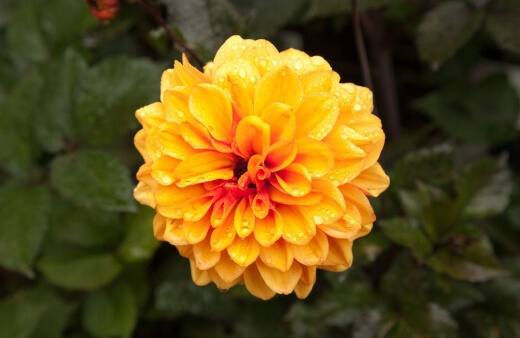 |
1. Dahlia ‘Poppers’

Source: digthedirt.com
Dahlia David Howard has painterly red and yellow streaks across each of its petals, forming a tight, spiky pom pom at the end of 1.5m flower stalks.
This particular cultivar is a hybrid between pompom and cactus dahlias, and shows it with the tight spikes of petals, gathered together to form a tight ball.
If deadheaded regularly, Dahlia ‘Poppers’ can flower right through from late spring to early fall.
2. Dahlia ‘Arabian Night’

The large deep, almost blood red, pompom of Dahlia ‘Arabian Night’ makes it perfect for almost any planting style, with looser foliage that tends not to grow beyond 30-40cm tall making it ideal for mixed borders where flowers are allowed to protrude and shoot up through green carpets.
3. Dahlia ‘Bishop of Llandaff’

Not all dahlias are the showy pompom or cactus types. Some are much more delicate, with subtle flowers more similar to Japanese anemones than the dahlias we tend to be familiar with in Australia.
Dahlia ‘Bishop of Llandaff’ is a humble perennial which will reliably flower year after year in Australia, but will need plenty of water to maintain the dark, near black, foliage around its base.


Get Your Free Guide:
Master Growing Australian Natives eBook
A Must Have Complete Guide for Every Australian Garden
Get Your Free Guide:
Master Growing Australian Natives eBook
A Must Have Complete Guide for Every Australian Garden
4. Dahlia ‘Brittany Rey’

Source: idigdahlias.com
Dahlia ‘Brittany Rey’, affectionately known as Rhubarb and Custard in our house, is an acid pink dahlia, which opens up to reveal a creamy, egg yolk coloured centre.
If you want a true shock of colour in your border, you won’t find a more confident dahlias out there. Dahlia ‘Brittany Rey’ grows to just under 1.5m tall in most conditions, but prefers good drainage and regular drinks.
5. Dahlia ‘Bora Bora’

Source: gardentags.com
Dahlia ‘Bora Bora’ is a classic cactus dahlia, with tightly curled red petals, each fading to yellow at the centre making them stand out to pollinators. As Dahlia ‘Bora Bora’ reaches just under 1m they can flower quite early, often in late spring.
Like any cactus dahlia, check flower buds for signs of damp and remove any dried sepals that are holding flowers shut. This helps to encourage a more open flower.
6. Dahlia ‘Crazy Love’

The elegant blush of Dahlia ‘Crazy Love’ is just stunning. If you’re growing your own bouget, or want to set up your own cut flower border, you shouldn’t be without this classic.
Dahlia ‘Crazy Love’ is perfect for the centre of flower arrangements, with long uninterrupted stems that should be cut right back to the lowest node when harvested, allowing new, slender stems to shoot up.
Dahlia ‘Crazy Love’ usually grows to around 90cm, but can reach 1m if they are individually mulched around the crown in winter.
7. Dahlia ‘Black Narcissus’

Source: dutchbulbs.com
Dahlia ‘Black Narcissus’ needs well drained soil and full sun. Any shade will cause stunted or uneven growth, while sitting in water can completely rot their roots.
This is a rule for any cactus dahlia, but Dahlia ‘Black Narcissus’ is particularly picky.
8. Dahlia ‘Tutti Frutti’

Source: evelyns-garden-and-nursery.myshopify.com
The appropriately named Dahlia ‘Tutti Frutti’ looks just like pulled taffy, with soft pink petals that look good enough to eat (which is lucky, because they’re edible and have a gorgeous carroty flavour).
While they’re not the tallest Dahlia, they still reach 90cm in decent conditions, and are relatively simple to grow, tolerating partial shade, and occasional dry spells reasonably well.
9. Dahlia ‘Jitterbug’

Source: dahliasbyjulie.com
Dahlia ‘Jitterbug’ is a miniature dahlias, and completely perfect for pots, with taller plants shooting through its foliage. The peachy flowers are just 1-2cm in diameter and look great around the base of formal flower arrangements.
10. Dahlia ‘David Howard’

Named after the British royal gardener David Howard, this dahlia grows to just 75cm so is perfect for formal gardens, where foliage wants to be kept under control.
The disadvantage of Dahlia ‘David Howard’ is that they are very susceptible to frost, so can die if left in the ground over winter in southern states. Try to keep them covered or mulch with compost to protect them if possible.
How to Grow Dahlias in Australia
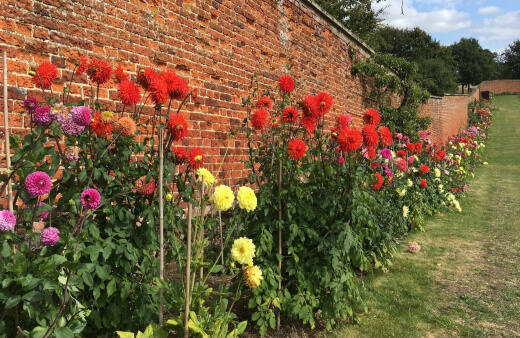
Dahlias are best grown from tubers, which many gardeners keep during the winter, to be replanted during the spring. However, these tubers can also be bought from your local garden centre at the start of spring.
Dahlias are a plant that enjoy warm and sunny conditions, which is why it’s so important to remove them from your garden to over-winter them. Luckily, they can be replanted year after year if over-wintered correctly.
When planting, it’s important to choose a sheltered, sunny spot with plenty of moist but well-draining soil. A south or west-facing spot is ideal. Soil can also be supplemented with a little bit of manure of organic matter to support your young dahlia plants.
Before planting, it’s a good idea to acclimate your plants first. Keep your tubers near the spot of planting for one or two days prior.
How to Plant Dahlias
Dahlias need lots of space to grow. While the tubers may initially look quite small, they grow exponentially once they really get going.
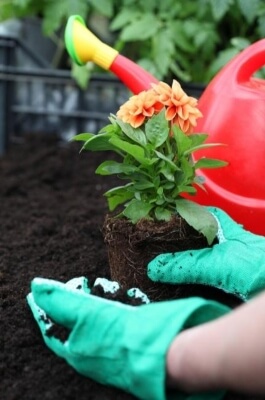
Growing dahlias in the ground:
- Dig a 30 centimetres wide hole into the ground.
- Using a garden fork, loosen the soil around the hole to make it easier for roots to expand.
- Pour a bucket of water mixed with compost into the hole, and then place it in your tubers.
Be sure to grow tubers a minimum of 60 centimetres apart.
When growing dahlias in a pot:
- Be sure to choose a big enough pot that is a minimum of 30 centimetres wide and deep.
- Choose a rich potting medium that is supported with some compost or manure.
How Quickly Do Dahlias Multiply?
Dahlia tubers begin to produce 5 to 6 new, strong shoots within the first two to three weeks of planting.
You then have the option to leave each stem to grow into a large dahlia plant or to use a method of tubular division to propagate new plants. Division should be done using a sharp, sterilized knife. Take extreme care to divide each of the shoots, keep some of the tubes intact, and have as many roots per shoot as possible.
The divisions can then be planted into some shallow compost to root. Once new growth appears, they can be replanted as above.
How to Propagate Dahlias

Dahlias are incredibly simple to propagate from seed in Australia and can be sown outdoors in early spring, right through to early summer, but by far the most effective way to create new dahlias is by dividing your old ones and propagating dahlias from tubers.
Below, we’ll look at both methods in detail:
Propagating Dahlias from Seed
To propagate dahlias from seed, you can either prepare an area of open compost in the garden or sow in seed trays. For both methods, use free-draining compost, and ensure good drainage.
Then simply sow dahlias thinly and water them well. Leave them somewhere with full fun and keep the ground moist for the next two weeks. They should germinate quickly, but can often take a long time to establish.
Dahlia Propagation from Cuttings
Propagating dahlias from basal cuttings is a great way to get into plant cuttings as they are very simple to take, don’t require any special materials and often take even if you forget about them entirely.
To take dahlias cuttings, follow the steps below:
- In spring, when new growth appears, scrape back the soil around the base of your dahlia, until you see the roots.
- Where new growth emerges, use a sharp knife to cut off a small section of root with a new young shoot fully intact (10cm tall, max.)
- Remove half of the outer leaves with a clean knife.
- Fill a small pot with rich compost (this is a growing plant, not a seed, so it needs nutrients).
- Dib a small hole in the centre of the pot.
- Plant the cutting so the root section is 2-3cm deep.
- Water well.
- Cover with a clear plastic bag, or mist daily to reduce moisture loss.
- When new growth appears, and roots appear at the base of your pot, it's ready to plant in the garden.
- Your cutting should flower the same year.
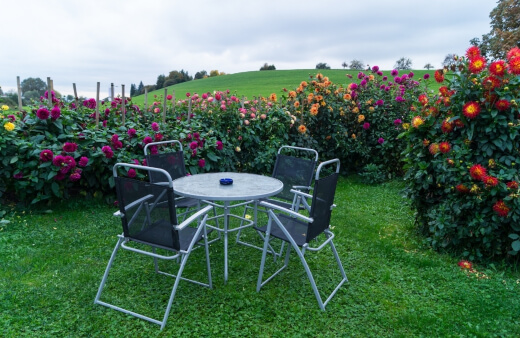
Propagating Dahlias from Root Cuttings/Tubers
Dahlias root cuttings are best taken after flowering, or before new shoots emerge in spring. This is because the plant is dormant, so can callous over before putting its energy into new growth.
The stress of dividing tubers triggers healthy growth, and can also help extend the life of your mature dahlias plants.
There are two ways to take dahlia root cuttings. One is to take clumps of roots through a method known as division, where you simply dig out half of the plant in spring when shoots appear from the soil.
This way, you re-invigorate the original plant and have a pre-grown half-plant to move elsewhere. This will flower weakly in its first year, but burst into life the second year.
The second way is more intricate but can produce more dahlias. Follow the steps below to take dahlias root cuttings:
- Dahlia tubers grow in clumps underground, expanding, and growing new tuberous material every year as top growth dies back. Each tuber is capable of producing several plants.
- To separate dahlias in winter, dig them up, and clean off the root ball.
- Find points where healthy, light brown, tubers meet and simply snap them off. You can take up to 1/3 of the tubers off the plant, but no more!
- Leave the snapped tubers, and the original plant to callous over for two days to avoid bacteria and fungus entering during winter.
- Cover with clean, loose, dry compost.
- Keep somewhere dry, cool and dark until spring, then remove them and expose them all to light.
- After a week of light exposure, the original dahlia, and the new tubers should have shown signs of new shoots.
- These can all be planted back into the ground individually.
Caring for Dahlias
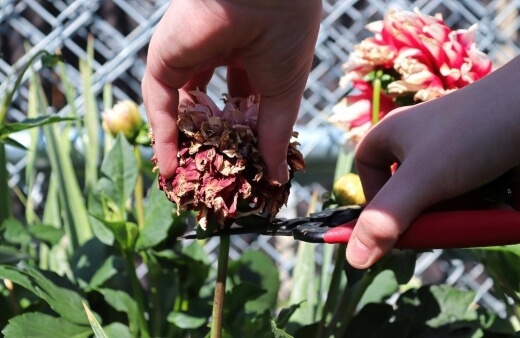
Dahlias grow incredibly fast and may sometimes need a little extra support. For larger growing varieties, it may be a good idea to stake weaker shoots, especially as they begin to produce large and heavy bulbs.
Unless it’s a very rainy season, Dahlias will require a lot of additional water. They like the soil moist but not water-logged. So, take the time to regularly check your soil, especially growing in the ground.
Although not always necessary, it can be beneficial to feed your dahlias every other week. Most gardeners recommend using a high potassium fertiliser, like tomato feed.
Deadheading your dahlias is also recommended to promote more flowers. When deadheading, take extreme care to only cut back spent flowers and not new buds. These can be quite easily mistaken.
What About Overwintering?
Unfortunately, dahlias rarely survive the winter if left outdoors, even in areas like Australia, where the winters can be slightly milder. Any form of frost may kill off your bulb and result in stunted growth for the following year.
This is why many gardeners recommend removing your dahlias during the winter. You will need to:
- Cut the stems to approximately 12 cm tall.
- Using a gardening fork, loosen the soil around the base of your dahlias.
- Using your hands, gently pull the tubular from the soil and dust off gently.
- Cover your tubulars in some newspaper and allow them to dry out for a few days.
You can keep your tubulars in some soil or compost, or even just a bag over winter. It is important, however, that you keep your tubulars away from any light or soil over the winter.
A dark room shed, or dark spot in your greenhouse can work well.
Common Dahlia Pests and Diseases

Dahlias Pests
Dahlias suffer from a few pests more than others, but are generally susceptible to every pest in the garden as soft-leaved herbaceous perennials with no essential oils in their leaves or stems to protect them from herbivorous insects.
One way to discourage pests, including aphids, slugs, thrips and spider mites from eating your prized dahlias is by spraying with a dilute garlic tea (crush half a bulb of garlic into 1L of warm water, and leave overnight, sieve, then pour into a spray bottle).
The garlic smell will put most pests off, and by mixing a few drops of dish soap in you also create an organic, low-grade pesticide which will suffocate any insect it is sprayed directly onto.
Dahlias Diseases
There are all sorts of problems that can affect dahlias, including root-knot nematodes, fungal infection and bacterial infections, but by far the worst problem is overwatering, or clay soils leading to rotten roots that will not recover.
Avoid this by planting dahlias in good quality compost over well-drained soil. This should be fairly simple as most of Australia’s garden soil is pretty free draining
Other problems include stem rot, and powdery mildew, which are both caused by poor air circulation, and carried by pests that leave traces of fungal spores and bacteria in cuts they create on the leaves and stems.
To treat stem rot, try spraying a mix of bicarbonate of soda and water onto the plant stems to dry them out and kill the fungus. If the problem persists, cut off the affected stems before the problem spreads.
For mildew on dahlias, the same treatment is proven to work reliably well.
Final Dahlia Growing Tips
- With so many varieties, it’s always a good idea to check the size and growing habits before purchasing your dahlia tubulars.
- If purchasing your tubulars from a garden centre, be sure to check the health first. Keep an eye out for any mould or rot.
To add more colour to your garden, don't miss our Magnolia ‘Little Gem’ and Ranunculus growing guides.
Dahlia Frequently Asked Questions
Will dahlias come back every year?
Dahlias will return in most Australian gardens every single year with very little help. They do not need to be dug up in winter but benefit from fresh mulches of compost over winter to protect them from any risk of frost and help to feed the soil.
Check out our guide on different types of mulch to know what they are and when to best use them.
Do dahlias grow in shade?
Dahlias can grow in shade but will be stunted and flower poorly. Dahlias need at least six hours of sunlight per day to grow healthily and reduce the risk of pests and diseases.
Should you deadhead dahlias?
Deadheading dahlias is an essential part of dahlias care. Deadheading extends the flowering season and adds colour to your borders right through summer, even into autumn in some climates.
Can you eat dahlias?
You can eat both the roots and flowers of dahlias. Dahlias have a vibrant carroty apple flavour in both the roots and their flower heads. By cutting the flower heads off as they begin to fade they can be added straight into salads or used to garnish cakes and deserts.
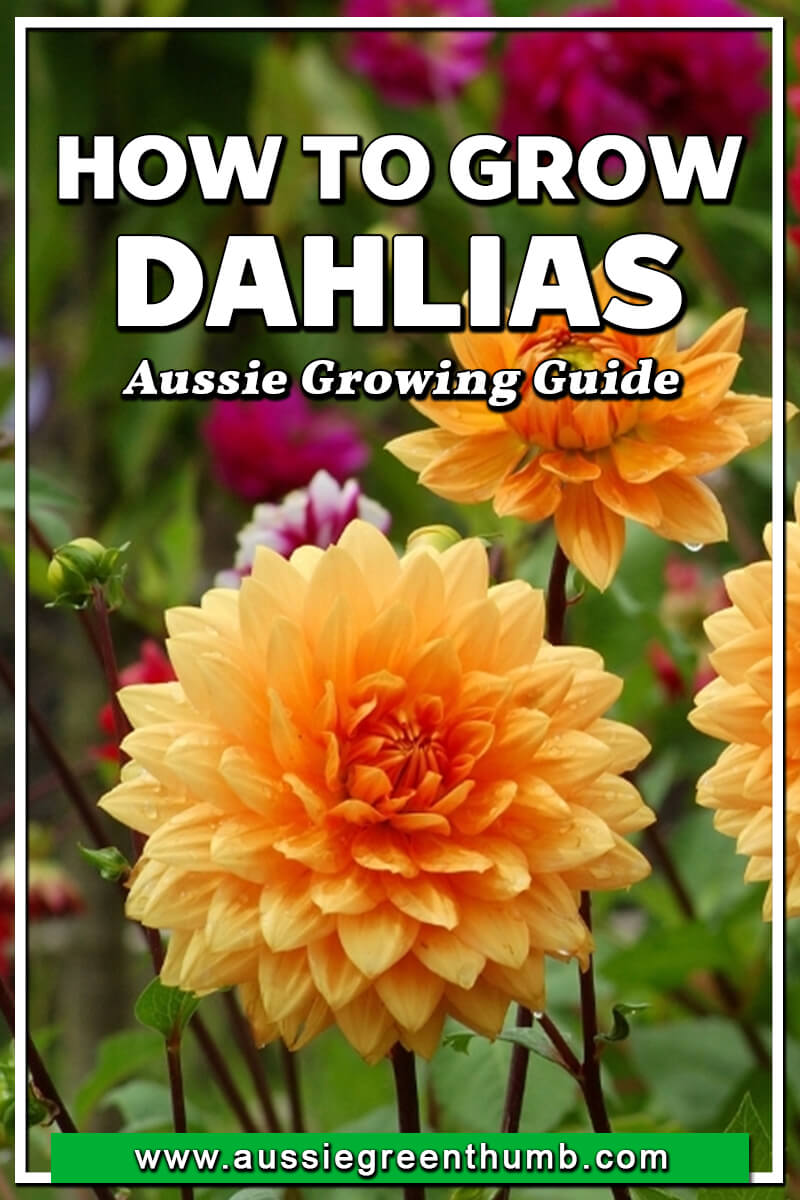
Wrapping Up Our Dalhia Growing Guide
So, there you have it. Everything you need to know about growing your very own dahlias at home: always be sure to give your dahlias as much sunlight as possible while keeping them in a semi-sheltered spot.
Wherever you decide to grow your dahlias, whether in a pot, near your patio, by a pond or as a focal point in your garden, with just a little bit of work, you’ll be able to enjoy glorious blooms throughout the summer.
Published on June 26, 2022 by Maisie Blevins
Last Updated on February 21, 2025




